Wednesday, April 29th 2015

Intel "Skylake" to be 6th Generation Core Series, First i7-6700K Benchmarks
Intel's next major CPU architecture, codenamed "Skylake," could be classified as the company's 6th generation Core processor family. It will succeed the brief stint Core "Broadwell" will have at the market, with no major chips for PC enthusiasts to look forward to. The Core i7-6700K appears to be the flagship product based on the Skylake-D silicon, succeeding the i7-4770K and i7-4790K. The Core i5-6600K will succeed the i5-4670K and i5-4690K.
The i7-6700K is a quad-core chip, with HyperThreading enabling 8 logical CPUs. Its nominal clock will be 4.00 GHz, with a rather shallow 4.20 GHz Turbo Boost frequency. It will feature an 8 MB L3 cache, and an integrated memory controller that supports both DDR4 and DDR3 memory types. This makes Skylake a transition point for the mainstream PC market to gradually upgrade to DDR4. You'll have some motherboards with DDR3 memory slots, some with DDR4 slots, and some with both kinds of slots. The resulting large uncore component, and perhaps a bigger integrated GPU, will result in quad-core Skylake parts having TDP rated as high as 95W, higher than current Haswell quad-core parts, with their 88W TDP.
Turkish tech publication PC FRM claims to have access to performance numbers of the i7-6700K and i5-6600K, which it probably sourced from engineering samples being circulated within the motherboard industry; compared to some popular current-generation chips from the segment. The i7-6700K, which features the same clocks as an i7-4790K, is 15 percent faster in most tests. Its performance is slotted somewhere between the i7-4970K and the six-core i7-5820K, in multi-threaded tests. In tests such as PC Mark, it outclasses every other chip in comparison, including the i7-5820K.
Sources:
PC FRM, Many Thanks to qubit for the tip.
The i7-6700K is a quad-core chip, with HyperThreading enabling 8 logical CPUs. Its nominal clock will be 4.00 GHz, with a rather shallow 4.20 GHz Turbo Boost frequency. It will feature an 8 MB L3 cache, and an integrated memory controller that supports both DDR4 and DDR3 memory types. This makes Skylake a transition point for the mainstream PC market to gradually upgrade to DDR4. You'll have some motherboards with DDR3 memory slots, some with DDR4 slots, and some with both kinds of slots. The resulting large uncore component, and perhaps a bigger integrated GPU, will result in quad-core Skylake parts having TDP rated as high as 95W, higher than current Haswell quad-core parts, with their 88W TDP.
Turkish tech publication PC FRM claims to have access to performance numbers of the i7-6700K and i5-6600K, which it probably sourced from engineering samples being circulated within the motherboard industry; compared to some popular current-generation chips from the segment. The i7-6700K, which features the same clocks as an i7-4790K, is 15 percent faster in most tests. Its performance is slotted somewhere between the i7-4970K and the six-core i7-5820K, in multi-threaded tests. In tests such as PC Mark, it outclasses every other chip in comparison, including the i7-5820K.
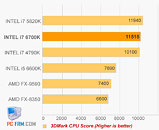
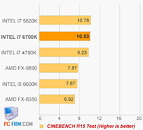
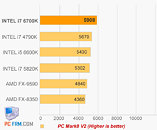
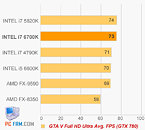
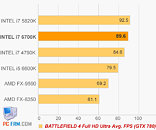
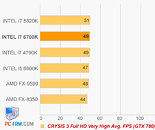
53 Comments on Intel "Skylake" to be 6th Generation Core Series, First i7-6700K Benchmarks
Only reason I can see for me to upgrade is for NVMe M6e m.2 drives.
As noted by other folks here, DDR4 is a perfect example of an unnecessary, over-hyped, option. With DDR3 running at 1600+ MHz. not being a system bottleneck on a discrete CPU powered PC, spending on higher frequency DDR3 or over-priced DDR4 is just throwing good money away. While the DRAM purveyors will love you, you gain almost nothing in desktop PC system performance for your money.
A technically educated consumer can make an informed purchasing decision and skip the hype.
If you're mainly using your PC for gaming, a new GPU should always be prioritized over a new CPU/platform, in the upgrade path.
In real world, daily use performance (gaming, startup, shutdown, app loading), the perceptible difference between a NVMe SSD and a regular SATA3 SSD will be virtually non-existent. You'd see maybe an improvement of 1-2 seconds in start-up times and level loads, at best. This is all a little myopic toward gaming PCs, but i have a feeling that's what the majority of TPU's readers have.
And protip: SSDs have zero effect on game FPS.
Just add as little as possible (they could give you a much better cpu but nooo that would make them less money) so that people still feel the "oh shiny new stuff, must buy".
Minimum effort, lots of power still in the bag for future releases, maximum profit.
Don't worry, your place is still safe